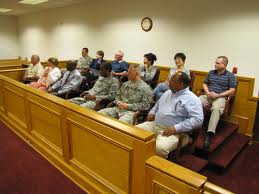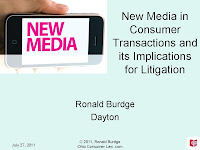 |
| It just isn't as easy as Perry Mason made it look. |
Of course, your questions and conversation (and that is what it should be) will revolve around the people and issues in your trial and those will often be unique to each particular trial. But there are some general guidelines that can apply to the voir dire in most trials.
Remember foremost that voir dire is the time for you to make friends with your jury. Do not cut it short and ask every question with a smile and warm expression on your face. You may naturally appear surprised at some juror comments but you should never appear dissatisfied, irritated or upset with a response.
You should be genuinely interested in learning all you can about each individual juror so ask open-ended questions that probe responses and promote conversation. Finding the right open-ended question can be extremely difficult so plan your questions out ahead of time so you can minimize the awkwardness of fumbling for the next thing to talk about.
At the same time, though, your manner should be relaxed and appear to be completely "off the cuff" and not planned out at all. The most effective voir dire should leave the jury thinking that you have nothing but a very bare outline of what you were interested in and you didn't stick to it.
One good technique is to outline the topics and areas that you want to cover. Ignore the language you want to use in the exact questions for the moment. Your starting point is just sort of a bullet list. After you are satisfied that you have everything covered, next start writing out the list of questions - phrased as if you were asking it in front of the jury. Write out every question you think would matter. When you are completely done and satisfied that you have covered it all thoroughly, read through your list one more time and put it away. Then, the day before the trial is to start, go over the list again. Finally, throw the list away.
Okay, that will be hard. But remember that it is more important to have the jury like you that it is to cover every question verbatim. Voir dire is about getting to know the jurors, yes, but it is also about getting them to feel comfortable with you and begin to like you and your manner and style. All of that is far more important than covering every little detail in every question on your list. This exercise (writing an outline and then all the questions and then discarding it) is designed to put the material in your mind in an organized fashion and not to give you a paper crutch to use during voir dire.
You can use humor as long as you do so carefully, lightly and tastefully. Be human and show compassion and attentiveness. Listen. If you don’t listen, you don’t learn about your jurors. If you don’t learn about them, you will seat the wrong jurors. And you know what happens when you seat the wrong jurors in the jury box.
Listening and engaging in conversation is critically important. Find out as much as you can about each juror. Use the customary questionnaires as a springboard for more conversation. At the same time, you have to strike a balance between inquiring and appearance obviously probing. The balance should be struck in favor of casual curiosity. Think of it as being a slightly more formal version of a dinner party where you get a chance to meet someone you do not know and learn more about them - and the object is for you to learn about them and not the other way around.
Knowing your case is critical. Keep it in mind and look for the chance to use juror responses as the opportunity to tie in your case proof and claim elements with juror experiences and responses. That can build a bridge between the jury's common experiences and the case you are going to present. The objective in this technique is to make your case personal for the jury, to get them invested in your side of the case so they want to help your client win.
And if your court process has you excuse a juror in front of the panel, always look at the juror and thank them in the same sentence that you exercise your peremptory. The rest of the panel will appreciate your courtesy and professionalism. If you excuse them only while speaking the judge, the rest of the jurors may think you are cavalier or, worse yet, don't care at all about them.
We could go on a long time about the importance of voir dire and the many books and articles that have been written, but we hope these few tips are enough for now.
Next time we will talk about your direct communication with the jury in your opening statement and why you need to be wary of the jury's sense of smell.










